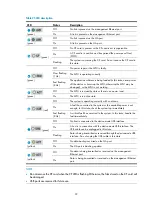
99
Appendix D Cables
This chapter describes cables used for connecting network ports.
Table 31
Cable description
Cable Port
type
Application
RJ-45 Ethernet ports
Connects RJ-45 Ethernet ports to transmit data.
SFP/XFP ports
Connects the fiber ports to transmit data.
Ethernet twisted pair cable
Introduction
An Ethernet twisted pair cable consists of four pairs of insulated copper wires twisted together. Every
wire uses a different color, and has a diameter of about 1 mm (0.04 in). A pair of twisted copper cables
can cancel the electromagnetic radiation of each other, and reduce interference of external sources. An
Ethernet twisted pair cable mainly transmits analog signals and is advantageous in transmitting data
over shorter distances. It is the commonly used transmission media of the Ethernet. The maximum
transmission distance of the Ethernet twisted pair cable is 100 m (328.08 ft). To extend the transmission
distance, you can connect two twisted pair cable segments with a repeater. At most four repeaters can
be added, which means five segments can be joined together to provide a transmission distance of 500
m (1640.42 ft).
Ethernet twisted pair cables can be classified into category 3, category 4, category 5, category 5e,
category 6, and category 7 cables based on performance. In LANs, category 5, category 5e, and
category 6 are commonly used.
Table 32
Ethernet cable description
Type Description
Category 5
Transmits data at a maximum speed of 100 Mbps.
Category 5e
Transmits data at a maximum speed of 1000 Mbps.
Category 6
Transmits data at a speed higher than 1 Gbps.
Based on whether a metal shielding is used, Ethernet twisted pair cables can be classified into shielded
twisted pair (STP) and unshielded twisted pair (UTP). An STP cable provides a metallic braid between the
twisted pairs and the outer jacket. This metallic braid helps reduce radiation, prevent information from
being listened, and eliminate external electromagnetic interference (EMI) of external sources. STPs have












































